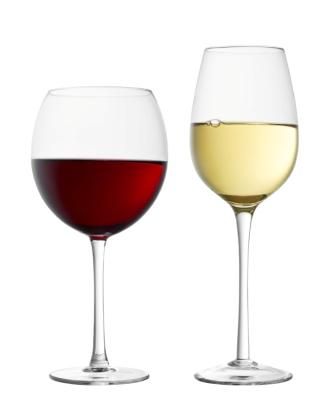U.S. airlines have spent the past few years making improvements to their first- and business-class cabins, from reclining seats that become plush beds to restaurant-quality meals. Despite those changes, one important area of upscale travel has lagged behind: the quality of the wine.
The reds and whites served by major U.S. airlines to first-class and business travelers have, until recently, been only marginally better than what’s served in the main cabin. That’s now changing, with legacy airlines (plus JetBlue Airways and Virgin America) spending heavily-and more strategically-to find wines that work in the harsh gustatory environment of a dry, pressurized cabin at 35,000 feet.
“If you’re in our first class or business class, I just assume you’re a joie de vivre-type person, and you travel a lot, and you love food and wine, and I want to give you the best adventure,” says Ken Chase, American Airlines’ wine consultant. JetBlue, which launched its Mint premium cabin in 2014, serves five California wines that include a counoise, a rare varietal made from a grape native to the south of France. Delta has recently served an Elouan pinot noir from Oregon, a state noted for its luxuriantly silky, and increasingly pricey, pinot noir. And pinot grigio has been virtually eliminated from premium cabins because it doesn’t “show” well in flight, wine experts say.
“If a wine has problems they will be magnified at altitude,” Jon Bonné, JetBlue’s wine consultant, said on April 7 at an event to unveil the airline’s spring menu.
Higher-quality, more interesting wines are largely a result of airlines’ financial rebound after a mostly disastrous decade following the 2001 U.S. terrorist attacks. With bankruptcies and mergers mainly behind them, carriers are more stable financially and have been spending heavily to improve fleets and premium cabins, aiming to align service with their upscale cousins in Europe and Asia. While wine served in economy class is still mostly moribund, such selections have been nearly eliminated from first and business classes. A non-scientific perusal by Bloomberg indicates that costlier wines such as Turley Wine Cellars’ “Juvenile” zinfandel and Jacquart ‘Mosaique’ brut Champagne are being served in premium cabins, though not always. Passengers in American Airlines’ “flagship first class,” for example, sip Bogle Vineyards Sauvignon Blanc, available in many U.S. cities for less than $10 a bottle. (The airline says that current, inexpensive offerings are filling supply gaps and will be replaced in July.)
None of the U.S. airlines are approaching the over-the-top wine luxury of such carriers as Emirates or Singapore Airlines; each pours Dom Perignon Champagne in first class (U.S. retail price, $150-$160). Singapore also operates, near its headquarters, a cellar in which wines are aged as long as seven years. “We take advantage of the sizzle of premium wine brands to reinforce the overall sense of luxury,” says Singapore spokesman James Bradbury-Boyd, calling sophisticated wine “one of the pillars of the brand.”
Despite improvements, wine budgets remain an easily controllable part of overall operating costs for U.S. airlines, which all give sommeliers clear guidance on how much to spend. (None of the airlines would disclose wine budgets.) That means a delicate balancing act because the retail price of a bottle matters, says Andrea Robinson, a master sommelier who has coordinated Delta Air Lines’ wine selections since 2007. She notes the common retail maxim that “your lowest price is your price” in the consumer’s mind. “Obviously the price could have a perceived value attached to it.” Robinson samples roughly 1,000 wines each summer to craft Delta wine lists, and a wine’s price and label both influence her decisions for premium-cabin choices. Any wine that is too inexpensive at retail-or bearing a label deemed overly casual, detracts from the type of gourmet- dining experience the airline wants to convey, and it won’t make the cut. United takes a different approach: Consulting master sommelier Doug Frost arranges wines for a blind taste test by a beverage committee, which scores the wines to help decide which will be served.
Still, if you’re accustomed to sitting in the back, it’s easy to wonder: Is U.S. airline wine really getting better? “I think from what I’ve seen at the legacy carriers, the answer is yes,” Robinson says. The industry is applying “more creativity” to catering budgets and has realized the importance of good wine selections to premium cabin service, she says. “In the overall budget scheme of things, [better wine] is not as impactful. but from a perception perspective, it’s very impactful.”
Bonné, a wine columnist for the San Francisco Chronicle who caught JetBlue’s attention with his 2013 book, “The New California Wine,” predicts that the industry’s wine offerings will improve further as carriers seek to sell more first- and business-class seats and offer fewer seats as upgrades. Although virtually no one buys a premium ticket solely for the wine, beverage quality “is going to be something that people pay closer attention to,” when they spend thousands for a ticket, he said. And there’s an additional, more pedestrian reason that airlines are serving up better wine: U.S. airlines match their international counterparts and pour for customers directly from the bottle, in keeping with the presentation of fine dining. Since passengers now see the label, jokes Chris Rossi, a senior executive at Virgin Atlantic Airways, “you don’t want to serve a bottle of Yellow Tail.”






